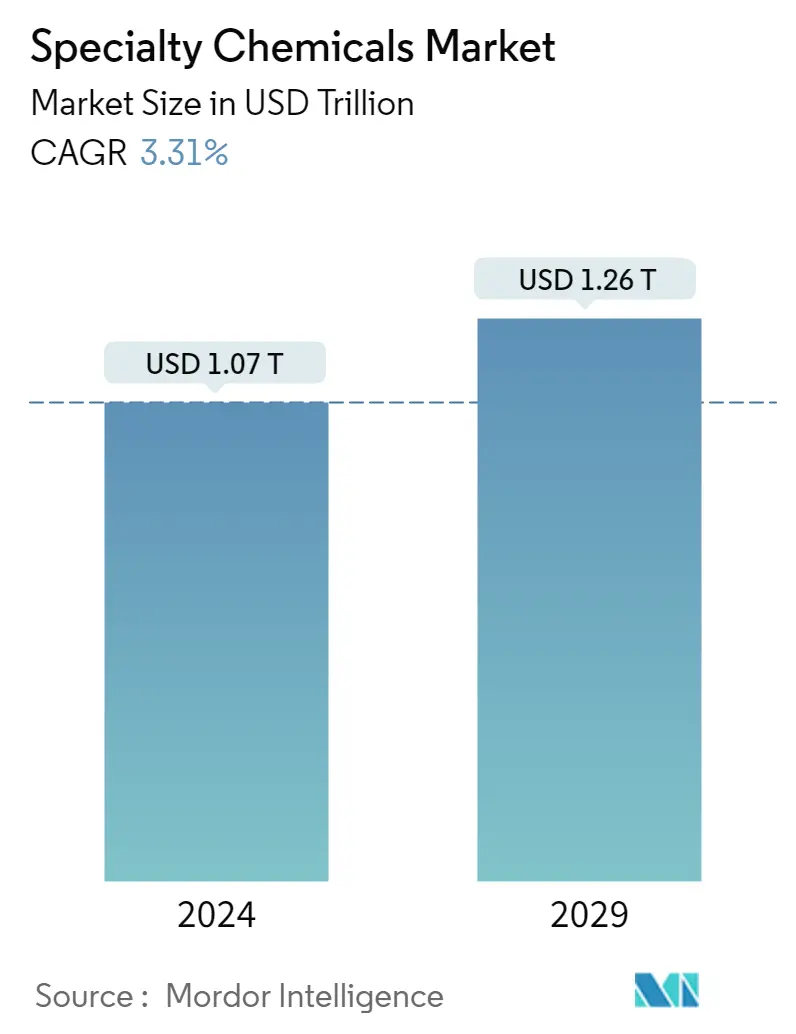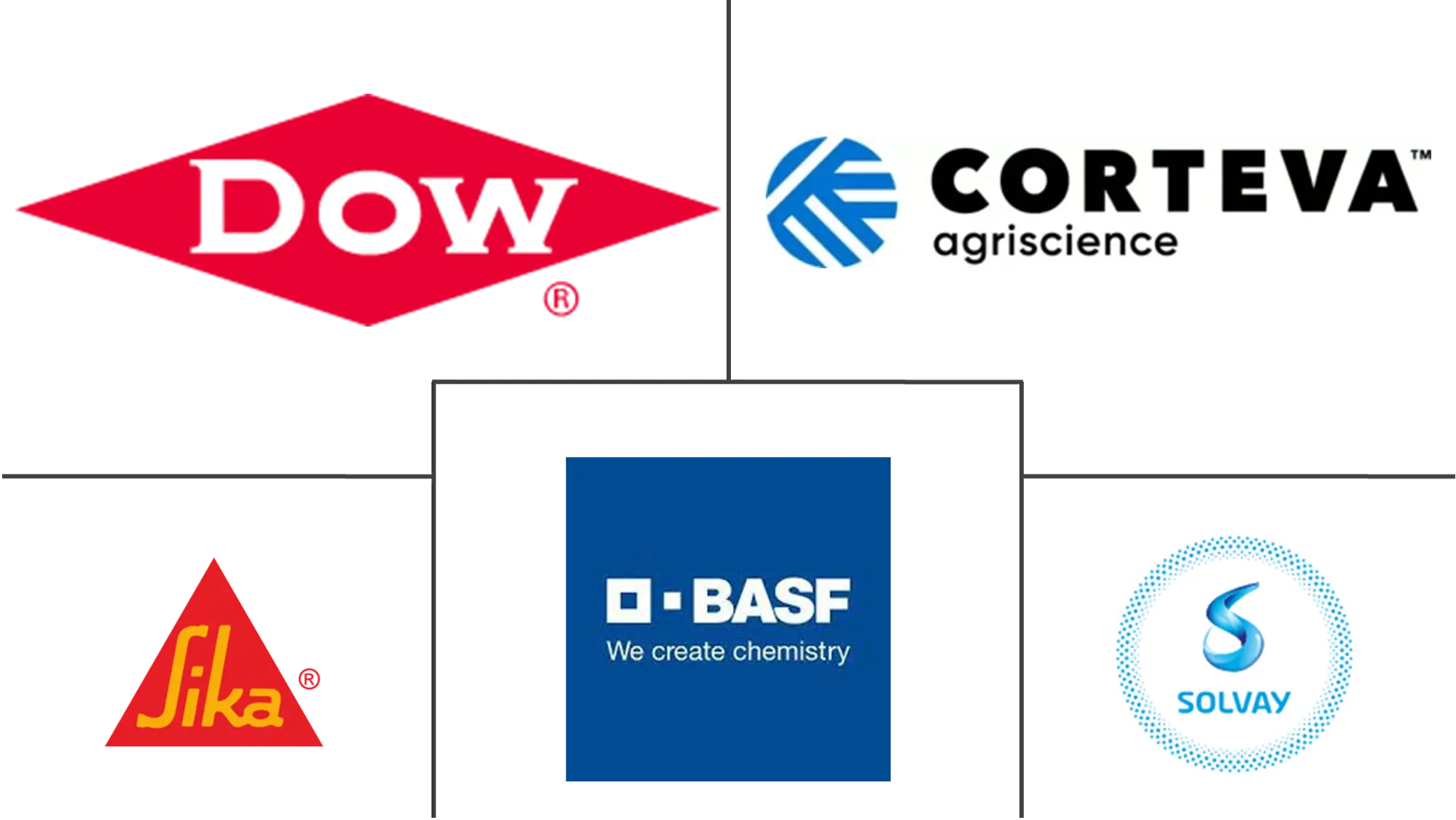Market Size of Specialty Chemicals Industry

| Study Period | 2019 - 2029 |
| Market Size (2024) | USD 1.07 Trillion |
| Market Size (2029) | USD 1.26 Trillion |
| CAGR (2024 - 2029) | 3.31 % |
| Fastest Growing Market | Asia Pacific |
| Largest Market | Asia Pacific |
| Market Concentration | Low |
Major Players
*Disclaimer: Major Players sorted in no particular order |
Speciality Chemicals Market Analysis
The Specialty Chemicals Market size is estimated at USD 1.07 trillion in 2024, and is expected to reach USD 1.26 trillion by 2029, growing at a CAGR of 3.31% during the forecast period (2024-2029).
The market was negatively impacted by the COVID-19 outbreak in 2020. Owing to the pandemic scenario, several countries went into lockdown, which led to supply chain disruptions, work stoppages, and labor shortages. However, the sector is recovering well since restrictions were lifted. An increase in house sales and new project launches have led to a rise in the demand for paints, coatings, and construction chemicals. The increasing demand for semiconductors, integrated circuits, and agrochemicals led to the market recovery over the last two years.
- The major factors driving the market's growth are the robust growth of construction activities, especially in Asia-Pacific and the Middle East & Africa. Furthermore, the growing population is propelling the demand for food worldwide.
- On the flip side, increasing environmental regulations and decreasing fossil fuel reserves are the restraints hampering the market's growth.
- Growing research and development for creating novel products will likely provide an opportunity for the market studied over the forecast period.
- Asia-Pacific dominated the global market, owing to the vast customer base, leading to high demand for specialty chemicals, increasing industrial production, and robust growth of the construction sector in the region.
Speciality Chemicals Industry Segmentation
Specialty chemicals are the chemical products on which many other industries, such as construction chemicals, paints and coatings, textile chemicals, mining chemicals, plastic additives, and others, rely. The applications of specialty chemicals include boosting agricultural, construction, pharmaceutical products processing, chemical and intermediates processing, food processing and ingredients for household, coatings and paper trading, and transportation. The Specialty Chemicals Market is segmented by paints and coatings (dynamics, application (architectural, automotive, industrial, wood, and other applications)), catalysts (dynamics, function (chemical synthesis catalysts, petroleum refining catalysts, and polymerization catalysts)), construction chemicals (dynamics, application (commercial, industrial, infrastructure, residential, and public space)), cosmetic chemicals (dynamics, application (hair care, skin care, oral care, personal hygiene and other applications)), dyes, inks, and pigments (dynamics, type (inks, dyes, organic pigments and inorganic pigments)), electronic chemicals (dynamics, application (semiconductor and integrated circuits, and printed circuit boards)), water treatment chemicals (dynamics, function (flocculants, coagulants, biocides and disinfectants, defoamers and defoaming agents, pH adjusters and softeners, and other functions)), food additives (dynamics, type (natural additives, and synthetic additives)), agrochemicals (dynamics, type (fertilizers, herbicide, fungicide, insecticide, nematicide, molluscicide, and other crop protection chemicals)), industrial and institutional cleaners (dynamics, application (general purpose cleaners, disinfectants and sanitizers, laundry care products, and vehicle wash products)), lubricant additives (dynamics, product type (dispersants and emulsifiers, detergents, oxidation inhibitors, extreme-pressure additives and anti-wear additives, viscosity index modifiers, friction modifiers, corrosion inhibitors, and other product types)), mining chemicals (dynamics, function (flotation chemicals, extraction chemicals, and grinding aids)), oilfield chemicals (dynamics, application (biocide, corrosion and scale inhibitor, demulsifier, polymer, surfactant, and other chemical types)), adhesives and sealants (dynamics, technology (water-borne adhesives, solvent-borne adhesives, hot-melt adhesives, reactive adhesives, other adhesives, and sealants)), plastic additives (dynamics, plastic-type (Polyethylene (PE), Polystyrene (PS), Polypropylene (PP), Polyamide (PA), Polyethylene Terephthalate (PET), Polyvinyl Chloride (PVC), Polycarbonate (PC), and other plastic types)), rubber processing chemicals (dynamics, application (tire, and non-tire)), specialty polymers (dynamics), textile chemicals (dynamics, application (Coating and Sizing Chemicals, Colorants and Auxiliaries, Finishing Agents, Desizing Agents, and other application)) and geography (Asia-Pacific, North America, Europe, South America, and Middle-East and Africa). The report offers market size and forecasts for Specialty Chemicals in revenue (USD million) for all the above segments.
| Paints and Coatings | |||||||
| Dynamics | |||||||
|
| Catalysts | |||||
| Dynamics | |||||
|
| Construction Chemicals | |||||||
| Dynamics | |||||||
|
| Cosmetic Chemicals | |||||||
| Dynamics | |||||||
|
| Dyes, Inks, and Pigments | ||||||
| Dynamics | ||||||
|
| Electronic Chemicals | ||||
| Dynamics | ||||
|
| Water Treatment Chemicals | ||||||||
| Dynamics | ||||||||
|
| Food Additives | ||||
| Dynamics | ||||
|
| Agrochemicals | |||||||||
| Dynamics | |||||||||
|
| Industrial and Institutional Cleaners | ||||||
| Dynamics | ||||||
|
| Lubricant Additives | ||||||||||
| Dynamics | ||||||||||
|
| Mining Chemicals | |||||
| Dynamics | |||||
|
| Oilfield Chemicals | ||||||||
| Dynamics | ||||||||
|
| Adhesives and Sealants | ||||||||
| Dynamics | ||||||||
|
| Plastic Additives | ||||||||||
| Dynamics | ||||||||||
|
| Rubber Processing Chemicals | ||||
| Dynamics | ||||
|
| Specialty Polymers | |
| Dynamics |
| Textile Chemicals | |||||||
| Dynamics | |||||||
|
| Geography | ||||||||
| ||||||||
| ||||||||
| ||||||||
| ||||||||
|
Specialty Chemicals Market Size Summary
The specialty chemicals market is poised for steady growth over the forecast period, driven by robust construction activities and increasing demand for agrochemicals, particularly in the Asia-Pacific and Middle East & Africa regions. The market is recovering from the disruptions caused by the COVID-19 pandemic, with a resurgence in demand for paints, coatings, and construction chemicals. The growing global population and the consequent rise in food demand are further propelling the agrochemicals segment, which is a significant contributor to the market's expansion. Despite challenges such as environmental regulations and dwindling fossil fuel reserves, the market is expected to benefit from ongoing research and development efforts aimed at creating innovative products.
Asia-Pacific remains the dominant region in the specialty chemicals market, supported by its vast customer base and increasing industrial production. The region's construction sector is experiencing significant growth, fueled by service sector expansion and investments from multinational companies. This growth is expected to drive the demand for various specialty chemicals, including adhesives, sealants, and construction chemicals. Additionally, the electronics and cosmetics industries are contributing to the market's expansion, with rising demand for cosmetic products and electronic components. The market is characterized by its fragmented nature, with major players like BASF SE, Dow, Corteva, Sika AG, and Solvay holding substantial market shares and actively expanding their operations to capitalize on emerging opportunities.
Specialty Chemicals Market Size - Table of Contents
-
1. MARKET DYNAMICS
-
1.1 Drivers
-
1.1.1 Robust Growth of Construction Activities in Asia-Pacific, and Middle East and Africa
-
1.1.2 Growing Population is Propelling the Demand for Food Worldwide
-
-
1.2 Porter's Five Forces Analysis
-
1.2.1 Bargaining Power of Suppliers
-
1.2.2 Bargaining Power of Buyers
-
1.2.3 Threat of New Entrants
-
1.2.4 Threat of Substitute Products and Services
-
1.2.5 Degree of Competition
-
-
1.3 Raw Material Analysis
-
-
2. MARKET SEGMENTATION (Market Size in Value)
-
2.1 Paints and Coatings
-
2.1.1 Dynamics
-
2.1.2 Application
-
2.1.2.1 Architectural
-
2.1.2.2 Automotive
-
2.1.2.3 Industrial
-
2.1.2.4 Wood
-
2.1.2.5 Other Applications
-
-
-
2.2 Catalysts
-
2.2.1 Dynamics
-
2.2.2 Function
-
2.2.2.1 Chemical Synthesis Catalysts
-
2.2.2.2 Petroleum Refining Catalysts
-
2.2.2.3 Polymerization Catalysts
-
-
-
2.3 Construction Chemicals
-
2.3.1 Dynamics
-
2.3.2 Application
-
2.3.2.1 Commercial
-
2.3.2.2 Industrial
-
2.3.2.3 Infrastructure
-
2.3.2.4 Residential
-
2.3.2.5 Public Space
-
-
-
2.4 Cosmetic Chemicals
-
2.4.1 Dynamics
-
2.4.2 Application
-
2.4.2.1 Hair Care
-
2.4.2.2 Skin Care
-
2.4.2.3 Oral Care
-
2.4.2.4 Personal Hygiene
-
2.4.2.5 Other Applications
-
-
-
2.5 Dyes, Inks, and Pigments
-
2.5.1 Dynamics
-
2.5.2 Type
-
2.5.2.1 Inks
-
2.5.2.2 Dyes
-
2.5.2.3 Organic Pigments
-
2.5.2.4 Inorganic Pigments
-
-
-
2.6 Electronic Chemicals
-
2.6.1 Dynamics
-
2.6.2 Application
-
2.6.2.1 Semiconductors and Integrated Circuits
-
2.6.2.2 Printed Circuit Boards
-
-
-
2.7 Water Treatment Chemicals
-
2.7.1 Dynamics
-
2.7.2 Function
-
2.7.2.1 Flocculants
-
2.7.2.2 Coagulants
-
2.7.2.3 Biocides and Disinfectants
-
2.7.2.4 Defoamers and Defoaming Agents
-
2.7.2.5 pH Adjusters and Softeners
-
2.7.2.6 Other Functions
-
-
-
2.8 Food Additives
-
2.8.1 Dynamics
-
2.8.2 Type
-
2.8.2.1 Natural Additives
-
2.8.2.2 Synthetic Additives
-
-
-
2.9 Agrochemicals
-
2.9.1 Dynamics
-
2.9.2 Type
-
2.9.2.1 Fertilizers
-
2.9.2.2 Herbicide
-
2.9.2.3 Fungicide
-
2.9.2.4 Insecticide
-
2.9.2.5 Nematicide
-
2.9.2.6 Molluscicide
-
2.9.2.7 Other Crop Protection Chemicals
-
-
-
2.10 Industrial and Institutional Cleaners
-
2.10.1 Dynamics
-
2.10.2 Application
-
2.10.2.1 General Purpose Cleaners
-
2.10.2.2 Disinfectants and Sanitizers
-
2.10.2.3 Laundry Care Products
-
2.10.2.4 Vehicle Wash Products
-
-
-
2.11 Lubricant Additives
-
2.11.1 Dynamics
-
2.11.2 Product Type
-
2.11.2.1 Dispersants and Emulsifiers
-
2.11.2.2 Detergents
-
2.11.2.3 Oxidation Inhibitors
-
2.11.2.4 Extreme-pressure Additives and Anti-wear Additives
-
2.11.2.5 Viscosity Index Modifiers
-
2.11.2.6 Friction Modifiers
-
2.11.2.7 Corrosion Inhibitors
-
2.11.2.8 Other Product Types
-
-
-
2.12 Mining Chemicals
-
2.12.1 Dynamics
-
2.12.2 Function
-
2.12.2.1 Flotation Chemicals
-
2.12.2.2 Extraction Chemicals
-
2.12.2.3 Grinding Aids
-
-
-
2.13 Oilfield Chemicals
-
2.13.1 Dynamics
-
2.13.2 Application
-
2.13.2.1 Biocide
-
2.13.2.2 Corrosion and Scale Inhibitor
-
2.13.2.3 Demulsifier
-
2.13.2.4 Polymer
-
2.13.2.5 Surfactant
-
2.13.2.6 Other Chemical Types
-
-
-
2.14 Adhesives and Sealants
-
2.14.1 Dynamics
-
2.14.2 Technology
-
2.14.2.1 Water-borne Adhesives
-
2.14.2.2 Solvent-borne Adhesives
-
2.14.2.3 Hot-melt Adhesives
-
2.14.2.4 Reactive Adhesives
-
2.14.2.5 Other Adhesives
-
2.14.2.6 Sealants
-
-
-
2.15 Plastic Additives
-
2.15.1 Dynamics
-
2.15.2 Plastic Type
-
2.15.2.1 Polyethylene (PE)
-
2.15.2.2 Polystyrene (PS)
-
2.15.2.3 Polypropylene (PP)
-
2.15.2.4 Polyamide (PA)
-
2.15.2.5 Polyethylene Terephthalate (PET)
-
2.15.2.6 Polyvinyl Chloride (PVC)
-
2.15.2.7 Polycarbonate (PC)
-
2.15.2.8 Other Plastic Types
-
-
-
2.16 Rubber Processing Chemicals
-
2.16.1 Dynamics
-
2.16.2 Application
-
2.16.2.1 Tire
-
2.16.2.2 Non-tire
-
-
-
2.17 Specialty Polymers
-
2.17.1 Dynamics
-
-
2.18 Textile Chemicals
-
2.18.1 Dynamics
-
2.18.2 Application
-
2.18.2.1 Coating and Sizing Chemicals
-
2.18.2.2 Colorants and Auxiliaries
-
2.18.2.3 Finishing Agents
-
2.18.2.4 Desizing Agents
-
2.18.2.5 Other Application
-
-
-
2.19 Geography
-
2.19.1 Asia-Pacific
-
2.19.1.1 China
-
2.19.1.2 India
-
2.19.1.3 Japan
-
2.19.1.4 South Korea
-
2.19.1.5 ASEAN Countries
-
2.19.1.6 Rest of Asia-Pacific
-
-
2.19.2 North America
-
2.19.2.1 United States
-
2.19.2.2 Canada
-
2.19.2.3 Mexico
-
2.19.2.4 Rest of North America
-
-
2.19.3 Europe
-
2.19.3.1 Germany
-
2.19.3.2 United Kingdom
-
2.19.3.3 Italy
-
2.19.3.4 France
-
2.19.3.5 Spain
-
2.19.3.6 Rest of Europe
-
-
2.19.4 South America
-
2.19.4.1 Brazil
-
2.19.4.2 Argentina
-
2.19.4.3 Rest of South America
-
-
2.19.5 Middle-East and Africa
-
2.19.5.1 Saudi Arabia
-
2.19.5.2 South Africa
-
2.19.5.3 Rest of Middle-East and Africa
-
-
-
Specialty Chemicals Market Size FAQs
How big is the Specialty Chemicals Market?
The Specialty Chemicals Market size is expected to reach USD 1.07 trillion in 2024 and grow at a CAGR of 3.31% to reach USD 1.26 trillion by 2029.
What is the current Specialty Chemicals Market size?
In 2024, the Specialty Chemicals Market size is expected to reach USD 1.07 trillion.

